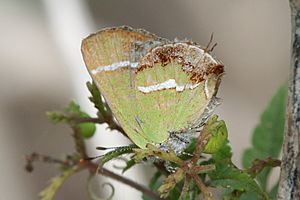Silver-banded hairstreak facts for kids
Quick facts for kids Silver-banded hairstreak |
|
|---|---|
 |
|
| Scientific classification | |
| Kingdom: | |
| Phylum: | |
| Class: | |
| Order: | |
| Family: | |
| Genus: |
Chlorostrymon
|
| Species: |
C. simaethis
|
| Binomial name | |
| Chlorostrymon simaethis (Drury, 1773)
|
|
| Synonyms | |
|
|
The silver-banded hairstreak (Chlorostrymon simaethis) is a small, colorful butterfly. You can find it in both North America and South America. It belongs to the butterfly family called Lycaenidae. People also call it the St. Christopher's hairstreak or the Key lime hairstreak.
Contents
What Does This Butterfly Look Like?
Colors and Patterns
Male silver-banded hairstreaks have dark, shimmery purple upper wings. Females are grayish-brown, but sometimes they have shimmery purple near the base of their wings.
The underside of the wings is a bright, lime green for both males and females. Both the front and back wings have a bright, silvery-white band across the middle.
Unique Wing Markings
On the back wing, the silver band sticks out towards the edge. Then, it turns back in, making a V shape. Beyond this band, there is a dark reddish-brown spot. This spot has some shimmery white areas. These shimmery white spots spread across the entire edge of the back wing.
The back wings also have one pair of tails. The wingspan of this butterfly is about 2.2 to 3.2 centimeters (about 1 inch to 1.25 inches).
How to Tell It Apart From Similar Butterflies
Amethyst Hairstreak Comparison
The amethyst hairstreak (Chlorostrymon maesites) is the only butterfly that looks very similar to the silver-banded hairstreak in the same areas.
The amethyst hairstreak is smaller. Male amethyst hairstreaks have dark, bright purplish-blue upper wings. Female amethyst hairstreaks have bright blue upper wings with dark tips on their front wings.
The underside of the amethyst hairstreak's front wing does not have a silver band. Its back wing has a silver band, but it does not go across the whole wing. Amethyst hairstreaks have two pairs of tails on their back wings.
Xami Hairstreak Comparison
Another related butterfly is the xami hairstreak (Callophrys xami). It is also called the green hairstreak.
The silver-banded hairstreak looks quite different from the xami hairstreak. The silver-banded species has a much wider silver-white line on the underside of its back wing. This line runs across the middle of the wing.
Where Does This Butterfly Live?
Preferred Environments
The silver-banded hairstreak lives in several types of places. These include subtropical woodlands, deserts, and hammock edges.
Subtropical woodlands are forests in warm areas, but not as hot as tropical ones. Deserts are dry, sandy places. Hammock edges are the borders of small, raised islands of trees in wetlands. These butterflies are only found in these places if their special host plants are nearby.
When Can You See This Butterfly?
Flight Times by Region
You can usually see the silver-banded hairstreak from May to December in southern Florida. In southern Texas, they fly from June to December.
In southern Arizona, they are seen from March to June. They also appear again from October to mid-November. Sometimes, they might fly to southern California in October.
These butterflies are usually a pretty light green with a white streak. Some people describe this butterfly as blue to light brown.
The Life Cycle of the Silver-Banded Hairstreak
Eggs and Caterpillars
The female butterfly lays her eggs one by one. She places them on the young fruits of the host plant. The eggs are shiny green.
The caterpillar lives inside the seed pod of the host plant. It eats the unripe seeds there. The caterpillar is yellowish-green to brownish. It has dark, wavy lines along its back and sides. There is also a dark greenish stripe down the middle of its back. This stripe has red oval shapes on each side. The caterpillar's head is tan.
Pupating and Chrysalis
Just before the caterpillar changes into a chrysalis, it turns red. The chrysalis (or pupa) is tan to grayish-brown. It has a gray stripe down the middle of its back. It is also covered in black and brown spots.
The chrysalis attaches itself to a surface using a silk pad and a silk belt. The silver-banded hairstreak usually has two or three generations (broods) each year.
What Do Silver-Banded Hairstreaks Eat?
Host Plants for Caterpillars
The caterpillars of the silver-banded hairstreak eat specific plants. These plants are called host plants.
Here are some of their host plants:
- Cardiospermum halicacabum – also known as balloon vine
- Cardiospermum corindum – sometimes called faux persil
- Eupatorium villosum – known as Florida Keys thoroughwort

